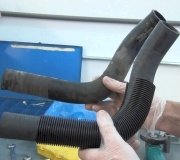In 30 years I have had car, it has no overheating history.
Car has original engine.
Radiator was replaced about 3 years ago with an aluminum core, plastic tank one.
Replaced heater core about a year ago.
Water pump about 4 years old.
Car is driven about 4 - 5,000 per year.
Coolant has been emptied and replaced several times, so it is clean and green.
Hot light came on a couple of days ago after freeway ride of about 8 miles for first time.
I put heater on and it went off after about a minute, but then flickered back on.
When I got home, about 5 miles after it came on, coolant came out of radiator through overflow hose.
Next morning, I checked for leaks. There were none.
Put in about a gallon and a half of coolant and water.
Did test ride today (outside temp 70º) and it overheated (hot light on), though no boiling over, after only 5 miles.
I opened hood to check.
Hose from thermostat to radiator was firm and hot.
Radiator was warm on the upper part of the core, cooler as it went down, and cool at the bottom.
Return hose to water pump was warm at best.
Using a laser thermometer, the temperature sender was 232º.
The upper radiator hose at the radiator was 220º.
The upper part of the radiator was 160º.
The lower part of radiator was about 80º.
With radiator cap off, it does look like there is circulation, and as it warms up, the coolant level rises and a bit comes out of the radiator cap opening (about a cup of coolant)
I took off upper hose at radiator.
No sign of blockage.
What do you think is wrong?
What should I check?
Thanks
SPONSORED LINKS
Thursday, November 22nd, 2012 AT 10:11 PM




